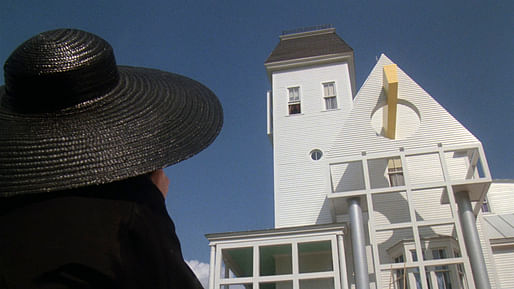

Every season has its own set of iconic movies, and within that set, there are those that stick out for their portrayal and elevation of architectural issues. Tim Burton’s 1988 classic, Beetlejuice, is perhaps the fall’s best example — an ever-trendy classic Halloween tale that showcases and offers some critique of the period’s salient design trends. Even the scale model of the town has some architectural qualities, and its central star — a shopworn Victorian-style home — has become an inspiration to aspiring designers around the world.
The conceit of Beetlejuice has essential elements that design students would be well-served to evaluate. Two families fighting for the creative control of a structure with radically different agendas. Its conflict is based on a disagreement about preferences in residential architecture: The “good, sturdy country craftsmanship” of a rural Victorian run up against a vacuous amalgam of 80s high design.
Filmed in Vermont, the story is set in the fictional town of Little River, Connecticut, which is a rather thinly-disguised stand-in of the state’s very real and charming literary capital of West Cornwall. The story can be examined through an architectural lens for two intersecting and of-the-moment reasons.
First, there are the film’s characters, led by local residents Adam and Barbara Maitland (Alec Baldwin and Geena Davis). Following their unfortunate demise via an adequate production fake of the town’s historic covered bridge, the young couple’s hopes for a modest remodel becomes grotesquely inverted when the Yuppie Deetzs’ (Jeffrey Jones, Catherine O’Hara, Winona Ryder) come to town ready to make it into a “summer arts destination” that rivals Southampton.
Including their former property developer father figure, Charles Deetz (Jones), the new family’s presence creates another narrative about gentrification and displacement. They are the overly erudite interlopers, intruding into the village, all in search of their own vanity, social position, and eventual financial gain.
Otho (Glenn Shaddix) is there as a stand-in for the design community. His effeteness, “Deliver me from L.L. Bean,” is characteristic of his role as the dutiful personal decorator for the family’s independent curator/art collector matriarch Delia Deetz, who is looking, as the film’s Wikipedia entry best puts it, to remake the quaint Victorian Maitland residence into a “pastel-toned work of modern art.”
Then there is the house itself, which set designer Bo Welch quite skillfully made appear as if it had been a genuine construction rather than a staged structure. After Otho’s three-month remodel that leaves only its attic unfinished, his vision includes the following:
And the function of these elements is entirely for art collector friends to remark on. All hope for the home’s retained wholesomeness is lost. That is until the Maitlands hire the movie’s titular “Freelance Bio-exorcist,” played by Burton’s beguiling alternate Michael Keaton.
Lydia’s room is the only mild delineation, opting for dark mauve accents and the spare original design over the polychrome post-modern exterior and high-end decor. You get a real sense that Otho has little patience for her, though their shared ability to connect to the afterlife is drawn out more the closer they both get to the Maitland’s third-floor garret.
Whether or not Burton intended to skewer the decade’s loudest tastemakers like Robert Venturi, Peter Eisenman, and Arquitectonica through the renovation is an open question.
In the end, everything is restored to its (super)natural order thanks to a mutual understanding that, mysteriously, returns the home to its original owners’ liking. What you’ll find most memorable about Beetlejuice is the style more than its plot or resolution. It has a timeless quality in line with many other Burton films. Just like the Maitland family, you’ll be stuck in the 80s.
1 Comment
Yes, they should watch-- for the characters as well as the sets.
Catherine O'Hara's Delia gave my boss nightmares; he thought she was exactly like one of our more horrible clients: a tiny, obnoxious, self-important artist who never shut up.
And who hasn't worked with (or against) an odious entity like Otho? I swear I had a coworker who-- despite laughing at the character-- seemed to directly emulate him.
Thanks for memory jog!
Block this user
Are you sure you want to block this user and hide all related comments throughout the site?
Archinect
This is your first comment on Archinect. Your comment will be visible once approved.